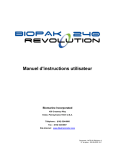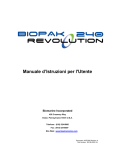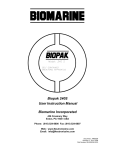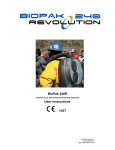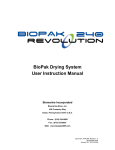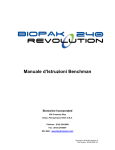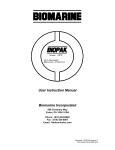Download User`s Manual - BioPak 240 Revolution
Transcript
User Instruction Manual Biomarine Biomarine-Ntron, Inc. 456 Creamery Way Exton, Pennsylvania 19341 U.S.A. Phone: (610) 524-8800 Fax: (610) 524-8807 Web: www.biopak240R.com Document: A47D134 Revision: G Part Number: B5-06-6000-14-0 June 2007 [ECO 8217] A47D134 BioPak 240 Revolution User Instruction Manual Part Number: B5-06-6000-14-0 Revision: G Table of Contents Subject Page Certification Approvals Cautions and Limitations S - Special or Critical User’s Instructions 3 6 6 Intrinsic Safety Consideration for Model/Type RMS Permissible Pressure and Temperature Monitoring Device Preparing for Use Revolution Monitoring System (RMS) Gauge and Tri-Color Indicator Module (TRIM) Function 8 9 14 Operating Instructions Post-Use Instructions Benchman Instruction Manual 16 19 19 Specifications Warranty 20 21 -2- BIOMARINE INCORPORATED 1 -3D47C012-01 C47C011 C47C010 D47C009 D47C008 D47C007 D47C006 D47C005 X X X X JMNOS 2 CAUTIONS AND LIMITATIONS S-Special or critical User's Instructions and/or specific use limitations apply. Refer to User's Instructions before donning. O-Refer to User's Instructions, and/or maintenance manuals for information on use and maintenance of these respirators. A47C003DLb Label Revision B [06/2007] N-Never substitute, modify, add or omit parts. Use only exact replacement parts in the configuration as specified by the manufacturer. BioPak 240 Revolution User Instruction Manual Part Number: B5-06-6000-14-0 M-All approved respirators shall be selected, fitted, used and maintained in accordance with MSHA, OSHA and other applicable regulations. J-Failure to properly use and maintain this product could result in injury or death. 2 CAUTIONS AND LIMITATIONS C47C019 SC-Self-Contained D47C013-01 PD-Pressure-Demand Small X D47C013-02 X Medium X D47C013-03 X Large X D47C014-01 X Non-Flame-Rated X D47C014-02 X Flame-Rated X B47C015 X D47C016 X North American C47C017 1 PROTECTION INTERNAL HEAT EXCHANGER OXYGEN CYLINDER ASSEMBLY HEAT EXCHANGER ASSEMBLY CARBON DIOXIDE ABSORBANT CENTER SECTION ASSEMBLY PNEUMATIC ASSEMBLY UPPER HOUSING ASSEMBLY LOWER HOUSING ASSEMBLY BREATHING HOSE ASSEMBLY B47C022 X MONITORING SYSTEM ASSEMBLY FACEPIECE Spray-On ANTI-FOG X ALTERNATE FULLFACEPIECE ASSEMBLY Facepiece Spectacle Kit Facepiece Magnetic Wiper X ALTERNATE HARNESS ASSEMBLY 240-MIN/3000 PSIG/SC/PD PROTECTION ACCESSORIES 13F-541 TC- RESPIRATOR COMPONENTS THESE RESPIRATORS ARE APPROVED IN THE FOLLOWING CONFIGURATIONS: CLOSED-CIRCUIT, PRESSURE-DEMAND, ENTRY AND ESCAPE, SELF-CONTAINED BREATHING APPARATUS BioPak 240R PHONE: (610) 524-8800; FAX: (610) 524-8807; WEB: WWW.NeutronicsInc.com 456 CREAMERY WAY, EXTON, PA 19341-2532 USA A47D134 Revision: G Certification Approvals SCBA NIOSH Certification: A47D134 BioPak 240 Revolution User Instruction Manual Part Number: B5-06-6000-14-0 Revision: G Carbon Dioxide Scrubber NIOSH Certification: BIOMARINE INCORPORATED 456 CREAMERY WAY, EXTON, PA 19341-2532 USA PHONE: (610) 524-8800 CLEAN AIR SCRUBBER CHEMCIAL SCRUBBER CANISTER TC-13F-541 CAUTIONS AND LIMITATIONS 1. Approved for use only In replacing or refilling chemical scrubber part number C47C010. 2. Not approved for use after indicated expiration date. 3. Do not re-use scrubber material. A47C024DLb REV. B [06/18/07] -4- A47D134 BioPak 240 Revolution User Instruction Manual Part Number: B5-06-6000-14-0 Remote Monitoring System (RMS) MSHA Electrical Approval: BIOMARINE - NTRON, INC. 456 Creamery Way, Exton, PA 19341 USA Model: RMS Permissible Pressure and Temperature Monitoring Device United States Department of Labor Mine Safety and Health Adminstration MSHA Approval No: 18-A060028-0 Tested for intrinsic safety in methane-air mixtures only. Warnings: The battery is to be changed in fresh air only. MSHA approved for use with one of the following 9-Volt batteries only: Eveready, Inc. Energizer #522 Panasonic Industrial Co. #6AM6 Rayovac Corp. #A1604 or Duracell, Inc. #MN1604 The connectors can only be connected to Biomarine BP240R Breathing Apparatus. -5- Revision: G A47D134 BioPak 240 Revolution User Instruction Manual Part Number: B5-06-6000-14-0 Revision: G Cautions and Limitations J-Failure to properly use and maintain this product could result in injury or death. M-All approved respirators shall be selected, fitted, and maintained in accordance with NIOSH, MSHA, OSHA, and other applicable regulations. N-Never substitute, modify, add, or omit parts. Use only exact replacement parts in the configuration as specified by Biomarine. O-Refer to User’s instructions, and/or maintenance manuals for information on use and maintenance of these respirators. S-Special or Critical User’s Instructions and/or specific use limitations apply. Refer to User’s instructions before donning. S- Special or Critical User’s Instructions (Cautions and Limitations) • All users of the Self-Contained Breathing Apparatus (SCBA) must be trained by Biomarine Qualified instructors in the donning, operation, inspection, and emergency use procedures of the BioPak 240 Revolution. • Biomarine must perform all repairs beyond the scope of this or the BioPak 240 Revolution Benchman Training manual. • Prior to using the BioPak 240 Revolution it must be determined that the user is medically fit. The following are some, but not all, medical and psychological conditions that could limit or prevent the use of the BioPak 240 Revolution. Emphysema Chronic Obstructive Pulmonary Disease Bronchial Asthma X-Ray evidence of Pneumonia Evidence of reduced pulmonary function Coronary Artery Disease Severe or progressive hypertension Epilepsy-Grand Mal or Petit Mal Pernicious Anemia Diabetes-Insidious or Mellitus Breathing difficulties when wearing a SCBA Abnormal or ruptured ear drum Claustrophobia or anxiety when wearing a SCBA Pacemaker or other Cardiac Conditions • Compressed Oxygen Hazard: Always handle oxygen cylinders with care to prevent damage. Do not allow oil, grease or other foreign materials to come in contact with cylinder, cylinder valve or cylinder pressure regulator to prevent possible ignition. Do not open the cylinder valve in the presence of open flame, sparks, or high radiant heat. Failure to follow these recommendations could result in personal injury or death. • Oxidizing Agent Hazard: Oxygen will enhance the combustion of other materials so that materials that normally will not burn in air may burn in oxygen-rich atmospheres; and, materials that do burn in air will burn more vigorously and at a higher temperature in oxygenrich atmospheres. Oxygen will not cause materials to ignite without the presence of an ignition source. • Work Load Stress Factors: The use of an SCBA will add to the workload and stress of the user. The user must be capable of determining when excessive ambient temperatures and high workloads will lead to physical exhaustion and/or collapse. • The BioPak 240 Revolution is suitable for respiratory protection during entry into and escape from oxygen deficient atmospheres with a temperature range of 5oF (-15oC) to 110oF (43oC). Please note that temperature range pertains to the ability of the SCBA to function under the stated temperature ranges and does not take into account human factors that may limit actual operational temperature range for a specific individual. For more information concerning -6- A47D134 BioPak 240 Revolution User Instruction Manual Part Number: B5-06-6000-14-0 Revision: G human heat stress factors reference Varley Report Heat Stress 04-107.pdf at http://www.biomarineinc.com/manuals.html • The BioPak 240 Revolution is approved only when the oxygen cylinder is fully charged with compressed medical or aviation grade oxygen with a moisture content less than 50 mg/m3 at 3000 psi/207 bar. Allow the oxygen cylinder to cool after filling to determine the correct pressure. DO NOT SUBSTITUTE ANY OTHER GAS TYPE FOR THE SPECIFIED OXYGEN. If the oxygen cylinder is improperly filled with any gas other than oxygen, the cylinder must be replaced. A foreign gas may cause cylinder corrosion. Warning: The oxygen cylinder shall be filled with the grades of oxygen specified above and no other type of oxygen or gas. The user bears full responsibility for the certification of purity of the oxygen contained within the oxygen cylinder. Should the oxygen cylinder be filled with a gas other than specified above, the cylinder shall be replaced. Always check for a current hydrostatic test date. DOT requires carbon fiber wrapped aluminum cylinders be tested by an approved facility on a 5year cycle from the date of manufacture. Cylinder inspections by the user as outlined in CGA 6.2 are must be done on a regular basis. • The user of the BioPak bears full responsibility for the certification of purity of compressed oxygen utilized within the oxygen cylinder. Use of non-approved gasses can result in serious injury or death to the user. • Prior to each use of this apparatus a fully charged oxygen cylinder, a fresh charge of carbon dioxide absorbent, frozen ice canisters, moisture control sponges and the phase change material (PCM) canister must be installed. • After each use of the SCBA thorough cleaning and disinfection of facepiece, breathing hoses and breathing loop must be completed in accordance with procedures provided in the BioPak 240 Revolution Benchman Instruction manual. • Use with adequate skin protection when worn in gases or vapors that poison by skin absorption (for example hydrocyanic acid gas). • Do not use any unapproved facepiece. Use only the facepiece approved for this apparatus. An unapproved facepiece will compromise the protection provided to the user by the SCBA. A good facepiece seal is important to achieving full protection and proper SCBA duration. Users should never wear the BioPak if they have any facial hair. A clean-shaven user will significantly increase his chances of achieving a good facepiece seal. A one-day facial hair growth is sufficient to cause the facepiece not to seal properly which will affect duration. • Always replace the battery of the Revolution Monitoring System (RMS) in a safe area known to be free of explosive gas mixtures or enriched oxygen atmospheres and with the cylinder valve closed and the SCBA purged of oxygen. Replace the battery when the low battery alarm has activated, after 200 hours of use or every 6 months which ever comes first. Instructions on how to replace the battery are located in the Benchman’s/Technician’s Manual. • The on-going effectiveness and reliability of any protective breathing equipment is dependent on the user/owner’s standard of care in maintaining the equipment, and the user’s expertise in using the equipment. • Personnel who intend to use protective breathing equipment in a dangerous atmosphere must have the proper training, temperament, and experience to be able to function safely. • The user shall periodically inspect the TRIM display as described in this manual to determine the status of the respirator oxygen supply. -7- A47D134 BioPak 240 Revolution User Instruction Manual Part Number: B5-06-6000-14-0 Revision: G Intrinsic Safety Consideration for Model/Type RMS Permissible Pressure and Temperature Monitoring Device: • Read manual before use. • The connectors of the monitoring device may only be connected to a Biomarine BioPak 240R Breathing Apparatus oxygen regulator, manifold block and breathing chamber. The fiber optic cable may only be connected to the BioPak 240R remote gauge assembly. • Tested for intrinsic safety in methane-air mixtures only. • Warning: The battery is to be changed in fresh air only. Do not change battery in hazardous area. Approved for use with one of the following 9-volt alkaline batteries only: Eveready, Inc Energizer #522, Panasonic Industrial Co #6AM6, Rayovac Corporation #A1604, Duracell, Inc. #MN1604. -8- A47D134 BioPak 240 Revolution User Instruction Manual Part Number: B5-06-6000-14-0 Revision: G Preparing for Use 1. Complete a general inspection of all components of the SCBA and facepiece to ensure all components are serviceable and in good working condition. Inspect the Turn-Around Maintenance Tag. It should be hanging from the waist belt of the SCBA. All the items must be checked off prior to SCBA use. Should any of the items not be checked off, or it is suspected that an item has not been completed, do not place the SCBA into service until all Turn-Around Maintenance items have been completed. 2. Remove the breathing chamber lid by sliding the eight slide latches to the open position. Use your fingers to remove the lid. Ensure three clean moisture control sponges are present and that the PCM canister is installed into position. Prior to use of the SCBA, the sponges must be wetted down and wrung out so they remain damp. Use of dry sponges will result in warmer than usual breathing gas temperatures. Moisture Control Sponges PCM Canister Warning: TO AVOID DAMAGING THE LID DO NOT USE A SCREWDRIVER OR OTHER TOOL TO REMOVE OR PRY OFF THE LID. ENSURE ALL EIGHT SLIDE LATCHES ARE IN THE OPEN POSITION. If significant force is required to remove the lid, lubrication of the lid and the lid o-ring with DOW 111 may be necessary. Over lubricating or stretching the large o-ring will cause the o-ring to roll out of the center section gland. -9- A47D134 BioPak 240 Revolution User Instruction Manual Part Number: B5-06-6000-14-0 Revision: G 3. Verify that presence of two CO2 scrubber canisters. If the CO2 canisters are not present install two fresh CO2 cartridge scrubbers and gaskets in the SCBA breathing chamber. Ensure the shelf life of the CO2 cartridges has not expired. Place each gasket on to the chamber lip and insert the CO2 cartridge. Each cartridge shall be installed with the red end up and visible after installation into the SCBA. Please note that each CO2 cartridge package contains one 4-hour use (two CO2 cartridges and two new gaskets) of CO2 absorbent. Ensure the gaskets are properly seated on the lip of the two center section absorbent openings. DO NOT USE ANY LUBRICANT ON THE GASKETS. Install the center section lid. Warning: Do not attempt to use any CO2 cartridge that is missing the red end cap. End cap should be visible on top of cartridge after installation into the SCBA. Warning: Do not attempt to breathe the SCBA with only one CO2 cartridge installed. Failure to install two new CO2 cartridges will result in high levels of CO2 and may lead to serious injury or death. Breathing the SCBA with CO2 cartridges that have been previously used or expired may cause serious injury or death. 4. Visually inspect the facepiece for any worn or damaged parts. The facepiece will have been stored with a coating of anti-fog spray applied to the lens. Install the optional wiper if desired. Lightly coat both halves of the wiper with water or anti-fog spray. Most, if not all users can maintain a fog free facepiece if the anti-fog insert and spray material is applied correctly to the facepiece lens. For best results, apply the anti-fog spray to a dry clean mask prior to storage and once again prior to use. Dirty or scratched lens surfaces will fog more quickly. Warning: Do not use a facepiece if it is worn or damaged. If the facepiece fails at any time during SCBA operation, the user must immediately exit to a safe area to doff the SCBA. - 10 - A47D134 BioPak 240 Revolution User Instruction Manual Part Number: B5-06-6000-14-0 Revision: G 5. Revolution Monitoring System (RMS) Gauge, Tri-color Indicator Module (TRIM), Alarm, and Battery Status Check a. With the fully charged oxygen cylinder (3000 psi/207 Bar) installed open the cylinder valve. It takes approximately 60 seconds for the RMS Gauge to show fully charged. b. When the oxygen cylinder valve is opened, the RMS will automatically power up and the RMS will perform a self-test. The self-test consists of an audible horn, and a red, green, blue light check. It also performs a battery status check. c. A continual flashing red, green, blue light followed by a short horn chirp in sequence indicates a low battery alarm. If the SCBA fails the battery self-test replace the battery as outlined in the Benchman’s/Technician’s manual. Warning: The purpose of the self-test is to ensure the apparatus has adequate battery power and the audible alarm and the TRIM warning lights are functioning. Apparatus that do not successfully complete a self-test must be serviced by a qualified Benchman/Technician. d. Close the oxygen cylinder valve. The RMS gauge and TRIM will automatically power down after completing a low oxygen alarm status indication (horn, red flashing light). 6. Remove the two coolant lids and insert a fully frozen ice canister with the label facing up into each coolant compartment. Reinstall the two coolant lids. Warning: The BioPak 240 Revolution frozen ice canisters and PCM canister are designed to cool the user’s breathing gases and are not designed to cool the user’s core body temperature. High ambient temperatures and work rates will increase inhalation temperatures. To maintain approvals the BioPak 240R must be used in accordance with this manual and at no times should the user breathe the SCBA without two frozen ice canisters and the PCM canister. - 11 - A47D134 BioPak 240 Revolution User Instruction Manual Part Number: B5-06-6000-14-0 Revision: G 7. Don the SCBA and facepiece. Open the oxygen cylinder valve by turning counterclockwise until the valve stops. The RMS gauge and display will perform the system startup as described in paragraph 5(b) above. Verify that a good face seal and proper check valve operation has been achieved. Facepiece seal and check valve operation is verified as follows: a. With two hands collapse the inhalation hose (left hose) and breathe in. Proper sealing of the exhalation (right hose) valve should result in the facepiece being pulled in toward the face. b. With two hands collapse the exhalation hose (right hose) and breathe out. Proper sealing of the inhalation (left hose) valve shall result in facepiece being pushed away from the face. Warning: The facepiece adapter MUST be installed with the breathing gas directional arrows facing UP. If the breathing gas directional arrows are facing DOWN the SCBA will not function properly. Failure to install the breathing hoses so the breathing gas directional arrows are facing up can result in serious injury or death. Warning: Immediately after donning the facepiece, the user MUST open the oxygen cylinder valve counter-clockwise to supply breathing gas. Failure to open the oxygen cylinder will result in serious injury or death. 8. Inspect the RMS gauge and TRIM. The TRIM lamp should be flashing green. - 12 - A47D134 BioPak 240 Revolution User Instruction Manual Part Number: B5-06-6000-14-0 Revision: G 9. Depress the emergency bypass valve for 1 to 2 seconds and verify that the sound of oxygen is heard during depression; and, that the oxygen flow stops after releasing the emergency bypass valve button. Remember the flow rate of the emergency by-pass valve is approximately 80-100 liters per minute. Excess use of the emergency bypass will reduce duration. Warning: Should the emergency bypass not function correctly during donning, do not use the SCBA with the failed valve. Should the valve ever fail during use in either the open or closed position the user shall immediately exit the location to a safe location for doffing of the SCBA. 10. The SCBA is now ready for use. The following nine steps are a review of the safety checks detailed in the “PREPARING FOR USE” paragraphs listed above. Users must always perform these prior to each SCBA use: (A) General inspection of SCBA and facepiece, Completed Turn-Around Maintenance tag (B) Moisture control sponges present, Phase Change Material (PCM) Canister in place (C) Ensure two new CO2 absorbent cartridges and two new seal gaskets are present (D) Anti-fog applied to the facepiece lens (E) RMS Gauge, TRIM, Alarm and Battery Status Check, cylinder @ 3000 psi/207 bar (F) Insert two fully frozen ice canisters (G) Don SCBA and facepiece, cylinder turned on, verify face piece seal and check-valve operation (H) TRIM flashing green verified (I) Emergency by-pass operational Caution: The user is cautioned to guard against restricting either of the breathing hoses during SCBA use. Breathing hoses can become restricted by the user when attempting to carry other equipment over the shoulder. Restricted breathing hoses may result in higher than normal breathing resistance and dangerously high levels of CO2. The use of anti-crush rings on the breathing hoses will prevent hose collapse when carrying equipment over the shoulder. - 13 - A47D134 BioPak 240 Revolution User Instruction Manual Part Number: B5-06-6000-14-0 Revision: G Revolution Monitoring System (RMS) Gauge and Tri-color Indicator Module (TRIM) Function The complete RMS Monitoring system will provide the user with continuous monitoring of the SCBA operational status. The user should periodically check the gauge and the TRIM during every mission. Should either the RMS gauge or TRIM stop displaying information during the course of a mission, the user should immediately exit the area to a safe location for doffing of the SCBA. Caution: The supply of oxygen to the user is NOT dependent on the proper operation of the electronic RMS and TRIM. If, however, the RMS fails to function or indicates a low oxygen alarm, the user should immediately exit the location to a safe area and doff the SCBA. The RMS Gauge, Alarm and TRIM system consists of a main power module and horn, located within the SCBA lower housing, and a Pneumatic Gauge and Tri-color Indicator Module, located at the end of the gauge line just below the pneumatic gauge. RMS Use The RMS Pneumatic Gauge, Horn, and TRIM work together to inform the user of the SCBA operating status. The gauge informs the user in PSI/BAR of how much oxygen remains. The TRIM indicates system operational, low battery and end of service life (20-25%) oxygen pressure and insert ice reminder. 1. Tri-color Indicator Module (TRIM) Operations: When the oxygen cylinder is turned on the TRIM will perform a system check to ensure the alarm and TRIM units are functioning properly. The start-up check consists of a horn sounding and a period of flashing lights (red, green, blue) followed by a flashing green light. 2. The end of service life alarm (low oxygen) sequence occurs when the oxygen cylinder reaches approximately 20 – 25% of service life. The red light will begin flashing and the audible horn will sound. The horn will initially sound for a period of 10-12 seconds, then cycle on and off periodically until the SCBA runs out of oxygen or is turned off. The end of service alarm (low oxygen) will override both the low battery alarm and the initial “Insert Ice Reminder”. 3. After five minutes of SCBA use the RMS will remind the user to insert frozen ice canisters if it believes that the user failed to install frozen ice canisters during start-up and donning. The “Insert Ice Reminder” is indicated by a flashing blue light lasting for a period of five-minutes. The reminder self-cancels after five minutes. 4. At start-up, a low battery alarm is indicated by flashing sequential red, green, blue lights with a short chirp from the horn. - 14 - A47D134 BioPak 240 Revolution User Instruction Manual Part Number: B5-06-6000-14-0 Revision: G 5. During operational use, the low battery life (Less than 60 minutes) is indicated by flashing sequential green, red, blue lights with a short chirp from the horn. WARNING: The user shall periodically inspect the TRIM housing for a flashing light indication. The flashing RED light is the primary indicator that there is a system fault or low oxygen supply. Whenever a flashing RED light or the sounding of the alarm horn is detected the user shall immediately exit the area to a safe location and doff the BioPak. AT NO TIME SHALL A USER CONTINUE USE OF THE BIOPAK SHOULD THE RED TRIM LIGHT BE FLASHING OR IN A STEADY STATE OF ILLUMINATION. - 15 - A47D134 BioPak 240 Revolution User Instruction Manual Part Number: B5-06-6000-14-0 Revision: G Operating Instructions Normal Breathing: The user should breathe in a normal manner. The SCBA will follow the demands of the user and there is no need for the user to accelerate or deepen normal breathing rates other than as required based upon workload. If, however, the user ever encounters difficulty in breathing the user MUST immediately exit the area to a safe area to doff the SCBA. Speaking: The standard facepiece is supplied with speaking diaphragms that will transmit through a protective barrier to the ambient atmosphere. Speak slightly louder and slower than normal making every effort to clearly pronounce words. Do not shout. Emergency Bypass Valve: The SCBA is supplied with a red-colored emergency bypass valve, located on the lower right-hand side of the lower housing underneath the oxygen valve. Depress this valve for 1 to 2 seconds to add oxygen into the breathing loop. The emergency bypass valve is intended for emergency use only. Continued use of the emergency bypass will shorten duration. The flow rate of the emergency by-pass is 80-100 liters per minute. This valve should not be depressed in attempts to cool the breathing gas or clear the facepiece of fog. RMS: The RMS gauge and TRIM will provide the user with various information concerning hazard alarms, oxygen supply and insert ice reminder conditions as described in the preceding section. The user should periodically consult with the gauge and TRIM to determine the status of the SCBA at all times. At any time the display unit indicates an alarm, the user shall take immediate action to exit the area to a safe location. Oxygen Supply: The RMS gauge will provide constant indication of remaining oxygen supplies. When the RMS system alarms due to low oxygen supply the user shall immediately exit the area to a safe location for doffing of the SCBA. Wiper (Optional): A magnetic wiper is available as an add-on option to the user. The wiper will function in conjunction with the Anti-Fog lens insert of the facepiece and the Anti-Fog spray. The wiper chamois shall be thoroughly cleaned of all dirt and debris and coated with Anti-Fog spray or water prior to donning the SCBA to prevent scratching of the facepiece lens. When fog or moisture accumulates on the facepiece lens, move the external wiper slide over the surface of the facepiece lens to sweep away accumulated moisture. Emergency Operation: In the unlikely event that a malfunction arises with the SCBA during use, the following guidelines should be trained for and utilized: Equipment Failure: Should any component or system of the SCBA experience a failure during use or, should the upper housing become dislodged, the user shall immediately exit to a safe location for doffing. Note that the SCBA will function as designed without the presence of the upper housing; however, the lack of the upper housing will now expose the internal SCBA components to the ambient conditions and increase the potential for SCBA damage. - 16 - A47D134 BioPak 240 Revolution User Instruction Manual Part Number: B5-06-6000-14-0 Revision: G Gauge Line Severing: If the RMS gauge line is severed, the user is instructed to exit the area immediately to an area that is safe to doff the SCBA. To conserve oxygen the BioPak 240R is equipped with a gauge line safety system. To eliminate the leak activate the RMS gauge line quick-disconnect located on the lower left-hand side of the SCBA. Pop off the retainer clip, and pull up on the quick disconnect flange. Retainer Clip Quick disconnect flange Caution: The user should never attempt to activate this safety option unless the gauge line has been severed or is suspected of leaking. This will result in the user not having the ability to determine cylinder pressure during operation. If this occurs, the user is instructed to leave the hazardous area immediately to a safe area to doff the SCBA. RMS Pressure Gauge and TRIM Failure: Should either the RMS gauge or the TRIM cease to function the user shall immediately exit to a safe location for doffing. Facepiece Pressure: A sudden change in facepiece pressure could indicate a component failure of the SCBA. Upon detection of such instances, the user should immediately exit the location to a safe area for doffing of the SCBA. Demand Valve Failure: Should the demand valve fail in the closed position the user may notice a decrease in the volume or a lack of breathing gas supply during heavy workloads. The user should immediately exit the location to a safe area for doffing of the SCBA. Additional breathing volumes can be supplied by depressing the emergency bypass valve to add oxygen as needed. Should the demand valve fail in the open position the user will notice constant adding of oxygen into the breathing chamber and rapid loss of oxygen. The user shall immediately exit the location to a safe area for SCBA doffing. Regulator Failure: Should the oxygen regulator of the SCBA fail during use the user is instructed to immediately exit to a safe location for doffing using the procedure below for SCBA operation. Regulator failure will be marked by a rapid decrease in the measured oxygen pressure of the oxygen cylinder. 1. Immediately close the oxygen cylinder valve. 2. Conserve breaths and immediately exit the area to a safe location for SCBA doffing in a calm and steady manner. 3. Briefly open, and then close, the oxygen cylinder valve on every fifth breath to replenish the supply into the breathing loop. 4. Repeat step 3 as many times as required until the safe area has been reached. - 17 - A47D134 BioPak 240 Revolution User Instruction Manual Part Number: B5-06-6000-14-0 Revision: G Duration: The BioPak 240 Revolution is rated and certified as a 4-hour duration respirator. Actual duration will vary per user and situation depending upon work rate, ambient temperature, face seal quality, SCBA maintenance quality and user oxygen consumption. The user shall always refer to the status of the SCBA provided by the RMS gauge and TRIM and NEVER estimate remaining oxygen supply by the time of the mission. When the RMS gauge, horn, and TRIM alarms notify the user of depleted oxygen supplies, the user shall IMMEDIATELY exit to a safe location for SCBA doffing. User Health Symptoms and Warning Signs: Should the user experience any of the below listed symptoms during use of the SCBA he should IMMEDIATELY exit to a safe location for doffing of the SCBA and seek immediate medical assistance. ¾ Feelings of nausea, dizziness or illness ¾ Rapid heartbeat or tightness in the chest ¾ Difficulty with breathing ¾ Smoke or other contaminates in the facepiece Cooling: The cooling of breathing air is provided by the frozen ice canisters, installed just prior to use, and the internally mounted PCM canister. Should one or both of the ice canisters completely thaw or if the user fails to install ice canisters, the breathing air temperature will rapidly rise. Ice canisters can be easily replaced during SCBA use in any atmosphere at any time. Changing the ice canisters will not breach the integrity of the breathing loop. Replacement is made by removing the cooling lids, replacing the spent ice canisters with a frozen ice canisters and reinstalling the cooling lids. Facepiece: Various accessories can be supplied to the user that will enhance the performance of the facepiece. Such options include the magnetic wiper, eyeglass support kits, and voice projection units. Users of the SCBA are also STRONGLY warned that the presence of ANY facial hair, including moustaches, beards, sideburns, etc., that come in contact with ANY sealing surface of the facepiece will severely hamper the ability of the facepiece to seal on to the face. A poor face seal for any reason will significantly limit duration. Users shall be clean-shaven when utilizing the SCBA. Users are also instructed to take measures to prevent hair from entering under the facepiece seal. Carbon Dioxide Poisoning: Failure to replace used CO2 scrubber cartridges, incorrect installation of CO2 cartridges, or failure to use any CO2 scrubber cartridges can quickly lead to carbon dioxide build up within the breathing loop and will lead to carbon dioxide poisoning. Upon such instances, the user should immediately exit the location to a safe area for doffing of the SCBA. During the egress from the location, the user should utilize the emergency bypass valve as needed to try to reduce carbon dioxide concentrations and supply additional oxygen. Carbon dioxide poisoning will be accompanied with symptoms of increased respiratory rates, dizziness, and/or confusion. - 18 - A47D134 BioPak 240 Revolution User Instruction Manual Part Number: B5-06-6000-14-0 Revision: G Post-Use Instructions 1. Verify that the hazardous area has been completely exited and that it is safe to remove the SCBA. 2. Close the oxygen cylinder valve by rotating to its full clockwise position and remove the facepiece. 3. Unbuckle the chest and waist belt straps, loosen the shoulder straps and doff the SCBA. 4. Submit the SCBA to Turn-Around Maintenance as outlined in the Benchman’s/Technician’s Instruction Manual. Warning: Failure to clean, disinfect, recharge oxygen cylinder, inspect the sealing washer between the cylinder and regulator, replace used carbon dioxide scrubbers, replace the PCM canister and frozen ice canisters before reuse as mandated in the Benchman/Technician Manual Turn-around Maintenance Procedure will lead to less than adequate SCBA performance and may result in injury or death to the user. Benchman/Technician Instruction Manual Each BioPak 240 Revolution is supplied with a Benchman/Technician Training manual. This manual will provide full details of Turn-around Maintenance, Long-Term Maintenance, Trouble Shooting, Illustrated Parts Lists and factory contacts. Users are encouraged to visit Biomarine on the worldwide web at http://www.biopak240R.com for product updates and various downloadable documents including Material Safety Data Sheets (MSDS), manuals, and other materials. - 19 - A47D134 BioPak 240 Revolution User Instruction Manual Part Number: B5-06-6000-14-0 Revision: G BioPak 240R Specifications Respirator Type: Self-Contained, Closed-Circuit, Pressure-Demand Respirator Duration: Certified as entry and escape, 4-hour duration Protection: Positive Pressure Size: 23.0 x 17.3 x 7.0” (584 x 439 x 178 mm) Weight: Ready to use 34 pounds (15.4 kg) Alarms: Green LED: Status Ok Red LED: Alarm Condition Blue LED: Insert Ice Reminder Horn: Alarm Condition 1 Operational Temperature Range : 5 to 110 oF (-15 to 43 oC) Storage Temperature Range: 40 to 90oF (4 to 32oC) Approvals: NIOSH: TC-13F-541 MSHA 18-A060028-0 US DOT-E11194 per DOT-CFFC Standards Transport Canada TC-SU 5303 Power: (1) 9-volt dc battery required for monitoring system Energizer #522 Panasonic #6AM6 Rayovac #A1604 Duracell #MN1604 Oxygen: 440 liters @ 3000 psi/207 bar Medical Grade or Aviation Grade Oxygen Moisture content less than 50 mg/m3 at 3000 psi/207 bar Tidal Volume: Over 6 liters Carbon Dioxide Scrubber: Dual, single use Calcium Hydroxide cartridges Non-dusting, non-settling, non-channeling, nonhazardous Cooling: Dual, Sterile, Distilled water ice canisters capable of replacement without breaking breathing loop. Fixed phase change material canister. Expected Battery Life: At ambient temperature above 40o F, 200 hours or 6 months whichever comes first. 1 Stated operational temperature range pertains to the ability of the SCBA equipment to function under the stated temperature ranges and does not take into account human factors that may limit actual operational temperature range of a specific individual. For more information concerning human heat stress factors reference the Varley Report Heat Stress 04-107.pdf located on the Biomarine website at http://www.biomarineinc.com/manuals.html. - 20 - A47D134 BioPak 240 Revolution User Instruction Manual Part Number: B5-06-6000-14-0 Revision: G Warranty Biomarine warrants, subject to the terms below, that the goods will be free from defects in design, materials, and workmanship for a period of three (3) years from the date that the goods are purchased by buyer, with the exception of rubber components. Rubber and silicone rubber components are similarly warranted for a period of one (1) year from the date of purchase. THIS WARRANTY DOES NOT APPLY TO OXYGEN CYLINDER HYDROSTATIC TESTING FOR PERIODIC RECERTIFICATION OF THE PRESSURE VESSEL. THE SOLE LIABILITY OF BIOMARINE FOR ALL PURPOSES SHALL BE TO REPLACE, AT THE SOLE OPTION OF BIOMARINE, DEFECTIVE PARTS APPEARING WITHIN THE THREE OR ONE-YEAR PERIOD AS APPLICABLE. BIOMARINE SHALL PROVIDE PARTS AT ITS OWN EXPENSE BUT ALL LABOR SHALL BE AT THE EXPENSE OF THE BUYER. BIOMARINE SHALL HAVE NO OBLIGATION FOR REPLACEMENT UNLESS: 1. BIOMARINE HAS RECEIVED WRITTEN NOTICE OF THE ALLEGED DEFECT WITHIN THIRTY (30) DAYS FOLLOWING THE DISCOVERY OF THE DEFECT OR THIRTEEN (13) MONTHS FROM THE DATE OF PURCHASE, WHICHEVER OCCURS SOONER; AND 2. THE BUYER SUBMITS PROOF OF DATE OF PURCHASE WITH INVOICE OR EQUIVALENT DOCUMENTATION; AND 3. THE DEFECTIVE GOODS ARE PROMPTLY RETURNED BY BUYER, AT THEIR SOLE EXPENSE TO BIOMARINE AT: 456 CREAMERY WAY, EXTON, PA 19341 USA; AND 4. THE EQUIPMENT HAS NOT BEEN ALTERED; AND 5. THE DEFECT OCCURS UNDER CIRCUMSTANCES OF PROPER USE IN ACCORDANCE WITH ALL INSTRUCTIONS AND MANUALS PROVIDED TO THE BUYER. It shall be the responsibility of the buyer to read carefully and abide by all instructions provided to the buyer in the instruction manual or elsewhere. If buyer, and the employees of the buyer, did not abide by such instructions, then the alleged defect shall not be deemed to have arisen under circumstances of proper use. The instructions for use of the goods reflect the opinion of experts based on field use and tests. The instructions should be followed carefully. It is impossible, however, to eliminate all risks inherently associated with the use of the goods. Unintended consequences may result because of factors as weather conditions, the presence of other materials, or the use or manner of application of the goods, all of which are beyond the control of Biomarine. The buyer shall assume all such risks. Buyer shall be responsible for insuring that the goods are functioning properly at all times and shall not use any goods, which are not functioning properly. If buyer uses goods when they are not functioning properly, then buyer agrees to defend, indemnify and hold Biomarine harmless against all losses, damages, and injuries to persons or property as a result of the use of the malfunctioning goods. These warranties do not extend to the goods if they have been subjected to misuse, neglect, or accident, including extended exposure to direct flames and/or caustic chemical products, after its delivery to buyer, nor does it extend to any item that was modified or altered after its delivery to buyer. IN NO EVENT WILL BIOMARINE BE LIABLE FOR ANY LOSS OR DAMAGE DIRECTLY OR INDIRECTLY ARISING FROM THE DEFECTS OR FROM THE USE OF THE GOODS OR FOR CONSEQUENTIAL OR INCIDENTAL DAMAGES, WHETHER IN CONTRACT, TORT, OR OTHERWISE, OR FOR PERSONAL INJURY OR PROPERTY DAMAGE OR ANY FINANCIAL LOSS. Any description of the goods contained in any documents to which these warranty provisions related, including any quotations or purchase orders relating to the goods being delivered to buyer, are for the sole purpose of identifying the goods, and any such description, as well as any sample or model which may have been displayed to or seen by buyer at any time, have not been made part of the basis of the bargain and have not created or amounted to any warranty, express or implied, that the goods would conform to any such description or any such sample or model. EXCEPT AS SPECIFICALLY SET FORTH IN THESE WARRANTIES, BIOMARINE MAKES NO WARRANTIES, EXPRESS OR IMPLIED, WHETHER ARISING BYLAW, CUSTOM, CONDUCT OR USAGE OF TRADE, INCLUDING WARRANTIES AS TO MERCHANTABILITY, OR AS TO THE FITNESS OF THE GOODS FOR ANY PARTICULAR USE OR PURPOSE, AND ANY WARRANTIES INCLUDING WARRANTIES AS TO MERCHANTABILITY AND FITNESS FOR PARTICULAR USE OR PURPOSE AND THE RIGHTS AND REMEDIES PROVIDED HEREIN ARE EXCLUSIVE. THESE WARRANTIES SHALL RUN TO THE BUYER ONLY AND SHALL NOT BE CONSTRUED AS A CONDITION. Biomarine does not warrant that the goods are free from the rightful claim of any third person by way of infringement or patents or other proprietary information or disclaims any warranty against such infringement. The terms of these warranties shall apply to the product sold by Biomarine, except absorbent, filters and anti-fog lens inserts which are considered “consumable item”, and as such are not covered by the terms of these warranties. No waiver, alteration, or modification of the terms of these provisions shall be valid unless in writing and signed by an executive officer of Biomarine. These warranties shall not apply to accessories or devices purchased by Biomarine and attached to or made part of the goods except that Biomarine warrants the (I) the installation of such items in the completed product shall so conform to the installation instructions of the manufacturers thereof as not to invalidate such applicable warranties on such items as are obtained by Biomarine from such manufacturers, and (ii) the workmanship incorporated in such installation shall be free from defects. - 21 -























